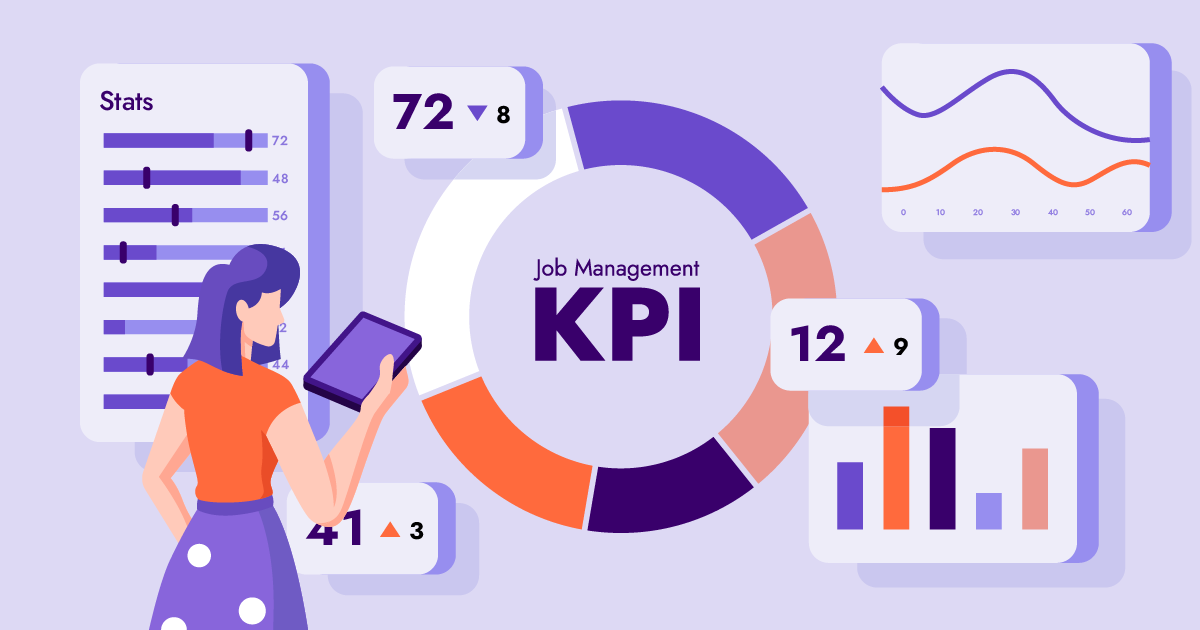Understanding and Leveraging Field Service KPIs for Business Success

Today, we’re diving into a crucial topic that can make or break your operations – Field Service software KPIs. Don’t worry if you’re new to the term; we’ll walk you through it step by step!
The Importance of KPIs in Field Service Operations
Picture this: you’re the captain of a ship, navigating through rough seas towards an unknown destination. In this metaphor, your ship represents your field service business, and the rough seas symbolize the challenges and uncertainties that come your way. As the captain, you need a reliable compass to steer your ship in the right direction, and that’s precisely what Field Service KPIs are for your business!
These Key Performance Indicators act as your trusty compass, guiding you through the ups and downs of field service operations. Without them, you’d be sailing blindly, making decisions based on gut feelings rather than hard data. But with KPIs in hand, you have a clear view of how your team is performing, where improvements can be made, and how to ensure customer satisfaction remains at the helm of your operations.
One of the most critical aspects of field service operations is the ability to resolve issues on the first visit. This is where the First-time fix rate KPI comes into play. It measures the percentage of times your technicians can successfully resolve a problem during their initial visit. A high first-time fix rate indicates that your team is well-trained and equipped, resulting in happier customers and lower operational costs.
Just imagine the impact of having a high first-time fix rate. Not only will your customers be delighted with a quick and efficient resolution, but your technicians will also feel a sense of accomplishment, boosting their morale and job satisfaction. Additionally, reducing the need for return visits saves valuable time and resources, allowing your team to tackle more tasks and serve more customers.
Now let’s set sail towards another essential KPI – Response time. In today’s fast-paced world, customers expect quick responses, and a delay could result in lost opportunities or decreased customer satisfaction. Tracking your Response time KPI is like ensuring your ship sails swiftly and promptly responds to any distress signals.
By staying on top of your Response time KPI, you can identify bottlenecks and areas that need improvement. Perhaps certain locations experience longer response times due to heavy traffic, or maybe specific technicians require additional support in managing their schedules. Armed with this data, you can fine-tune your operations and navigate around potential obstacles to deliver a seamless customer experience.
A successful captain knows that individual crew members’ performances can make or break the voyage. Similarly, tracking the Technician success rate KPI reveals how often your technicians complete a job successfully. By measuring their success rate, you can identify areas where additional training may be required or where processes can be improved, leading to better overall performance.
Your technicians are the heart and soul of your field service business. Their expertise and dedication directly impact the success of your operations. With the Technician success rate KPI, you can not only celebrate their achievements but also proactively address any issues that may be affecting their performance. By investing in their professional development and addressing any skill gaps, you can ensure your crew is well-prepared for any challenges that arise.
While it’s essential to measure individual technician success, understanding their overall productivity is equally vital. The Technician productivity rate KPI allows you to gauge how efficiently your technicians are handling multiple tasks and how effectively they utilize their time. Optimizing productivity can lead to increased customer satisfaction and a higher volume of completed jobs.
As the captain, you know that a well-organized crew maximizes efficiency and minimizes downtime. The Technician productivity rate KPI enables you to identify areas where workflows can be streamlined and resources allocated more effectively. Maybe certain technicians excel at specific tasks and can be assigned to those more frequently, or perhaps there are tools and technologies that can further enhance productivity across the board.
Meeting service level agreements (SLAs) is a top priority in field service. The Tasks and visits completed within SLA rate KPI tracks how well your team meets these commitments. Consistently exceeding SLAs can build trust with customers, leading to long-term loyalty and positive word-of-mouth referrals.
By keeping a close eye on the Tasks and visits completed within SLA rate KPI, you can ensure your ship remains on course, consistently meeting the expectations set for your customers. Timely service delivery and adherence to SLAs are vital components of customer satisfaction. And as we all know, happy customers are more likely to become repeat customers and advocates for your business.
Picture yourself on a long voyage, and suddenly, the wind changes direction. You need to adjust your sails to continue on your intended path. In the same way, monitoring Customer churn is essential for making course corrections in your field service business.
Customer churn is another KPI that should never be overlooked. It measures the rate at which you’re losing customers. A high churn rate can be indicative of issues in service quality, customer support, or pricing. By addressing the root causes of customer churn, you can focus on retaining existing customers, which is often more cost-effective than acquiring new ones.
Understanding why customers leave and making necessary changes to prevent churn can save your ship from sinking. Perhaps you notice a trend of customers leaving due to unaddressed complaints or recurring service issues. Armed with this knowledge, you can implement initiatives to improve customer satisfaction, such as increasing communication with customers, offering loyalty programs, or fine-tuning your service offerings.
To ensure uninterrupted service, tracking Service Uptime/Downtime is essential. This KPI helps you understand how often your services are available to customers and how much downtime occurs. Minimizing downtime can significantly impact customer satisfaction and prevent potential revenue losses.
Just as a captain is accountable for keeping the ship seaworthy, you, as a service manager, are responsible for ensuring your operations run smoothly without any interruptions. By tracking Service Uptime/Downtime, you can identify patterns or triggers that cause downtime and work towards preventing them.
Let’s imagine that you notice a recurring issue that leads to service downtime. Armed with this information, you can engage your team in root cause analysis to understand the problem fully. By identifying the underlying cause, you can implement preventive measures, such as better equipment maintenance or additional training for technicians, to minimize future downtime.
Technician Utilization is a valuable KPI that measures how well you’re using your workforce. By optimizing the allocation of your technicians’ time and skills, you can maximize efficiency and profitability. It also helps you identify any underutilized resources that can be redirected to areas with higher demand.
As the captain of your field service ship, you want to ensure that every member of your crew is actively contributing to the journey’s success. The Technician Utilization KPI allows you to assess how efficiently your technicians are being utilized across different tasks and locations.
Let’s say you notice that certain technicians have lower utilization rates compared to others. By investigating further, you may find that these technicians have specialized skills that are not being fully utilized. You can then allocate tasks that better align with their expertise, increasing their productivity and job satisfaction.
Lastly, we have Project profitability. This KPI assesses the financial success of individual projects. By monitoring project profitability, you can ensure that you’re delivering services that are not only meeting customer expectations but also contributing positively to your bottom line.
Projects are like mini-expeditions within your overall journey. Just as a captain must weigh the costs and benefits of each voyage, you must carefully assess the profitability of each project. By tracking Project profitability, you can identify areas where costs are exceeding estimates and make data-driven decisions to improve financial outcomes.
For example, you may discover that certain types of projects consistently result in lower profitability due to unforeseen expenses. Armed with this information, you can adjust pricing strategies, negotiate better deals with suppliers, or fine-tune your project management processes to increase profitability in the future.
Now that we’ve explored the vast sea of Field Service KPIs and their significance, it’s time to embark on the next leg of our journey – leveraging technology for effective KPI tracking.
Key Field Service KPIs Every Manager Should Know
Now, let’s get down to business and talk about the KPIs that matter the most in field service operations. First up, we have the First-time fix rate – a critical metric that measures how often your technicians can resolve an issue during their initial visit.
Next is the Response time – the time it takes for your team to respond to a service request. This one can make or break your customer satisfaction levels.
Another important KPI is the Technician success rate, which indicates how often your technicians successfully complete a job.
We also have the Technician productivity rate, which measures the efficiency of your technicians in handling multiple tasks.
Meeting SLAs is essential, so we have the Tasks and visits completed within SLA rate – a metric that ensures you’re meeting your promises to customers.
Keep an eye on Customer churn – the rate at which you’re losing customers, as it can have a huge impact on your business.
Service Uptime / Downtime is another vital KPI that tracks how often your services are available and the duration of any downtime.
Technician Utilization helps you optimize your workforce and ensure your technicians are being used efficiently.
Lastly, Project profitability measures the success of individual projects and their contribution to your bottom line.
Leveraging Technology for Effective KPI Tracking
Tracking and analyzing all these KPIs can seem daunting, but fear not! Technology comes to the rescue. With real-time data collection, automated reporting, and predictive analytics, you can stay on top of your KPI game effortlessly.
Thanks to advances in field service management software like FieldInsight, managing and leveraging KPIs has become more accessible and efficient than ever before. These platforms provide comprehensive tools for data collection, analysis, and reporting, allowing you to make informed decisions quickly.
FieldInsight’s real-time data collection capabilities empower your team to enter data directly into the system, eliminating the need for manual paperwork and reducing the chances of errors. With every update, your KPIs stay up-to-date, giving you a clear picture of your performance.
Automated reporting is a game-changer. FieldInsight can generate customized reports on your KPIs at the click of a button. You can schedule regular reports to be delivered directly to your inbox, allowing you to keep a close eye on your performance and make timely adjustments when necessary.
Predictive analytics takes KPI tracking to the next level. FieldInsight’s platform can analyze historical data and use machine learning algorithms to predict future trends and potential challenges. Armed with this foresight, you can proactively address issues and optimize your operations, ensuring continued success.
Setting SMART KPIs for Field Service Operations
As we set sail on our journey to navigate the waters of SMART KPIs, let’s steer our ship towards a destination of success and accomplishment. Just like plotting a course for uncharted territories, setting SMART KPIs requires careful planning and precision.
First and foremost, Specific KPIs act as the North Star guiding us towards our desired outcomes. Rather than setting vague objectives, we must define clear and well-defined targets. For instance, instead of a broad goal like “improve customer satisfaction,” a specific KPI could be “increase customer satisfaction rating by 10% in the next quarter.” This tangible target allows us to chart our progress and make informed decisions along the way.
Measurable KPIs serve as the compass, allowing us to keep track of our journey’s milestones quantitatively. By setting KPIs that are measurable using specific numbers or percentages, such as “reduce technician response time by 15%,” we can gauge our performance objectively. With measurable KPIs, we can assess whether we’re on course or need to adjust our sails to reach our destination.
As captains of our field service ship, we must be realistic and pragmatic when setting KPIs. Achievable KPIs ensure that our goals are within reach and attainable. While it’s tempting to aim for the stars, setting unrealistic objectives can lead to frustration and demotivation among our crew. We must assess our resources, capabilities, and historical data to determine what is feasible for our team to achieve.
Next, we must hoist the sails of Relevant KPIs that align with our business goals and objectives. Just as our ship’s sails catch the wind that propels us forward, relevant KPIs directly contribute to the success of our field service operations and support our broader business strategy. Every KPI we set should play a vital role in driving our business towards its ultimate vision.
And like setting a course with a determined arrival date, Time-bound KPIs provide a sense of urgency and direction. By defining clear timeframes for achieving our KPIs, we create a sense of purpose and motivation among our crew. Time-bound KPIs also help us break down our objectives into manageable milestones, allowing us to stay focused on meeting our targets.
Now, you might wonder how to put these SMART KPIs into practice for your field service business. Let’s take an example to demonstrate how these principles can be applied:
Imagine you aim to increase revenue through upselling and cross-selling additional services to existing customers. Your SMART KPIs for this objective could be as follows:
Specific: Increase revenue from upselling and cross-selling by $50,000 in the next quarter.
Measurable: Track the revenue generated from upselling and cross-selling on a monthly basis.
Achievable: Analyze historical data to assess the potential for additional sales and determine a realistic target.
Relevant: Upselling and cross-selling align with your business strategy of expanding customer lifetime value and enhancing customer satisfaction.
Time-bound: Set a deadline of three months to achieve the $50,000 revenue increase.
With these SMART KPIs in place, you have a clear roadmap for your upselling and cross-selling efforts. You can closely monitor your progress, identify any barriers to success, and make adjustments as needed. Moreover, you provide your crew with a shared vision and a purposeful mission, motivating them to work collaboratively towards achieving this revenue goal.
In summary, setting SMART KPIs is a strategic exercise that ensures we navigate the field service waters with clarity and purpose. By being specific, measurable, achievable, relevant, and time-bound, we chart a course that leads to success and achievement. As captains of our field service ship, let’s embrace the power of SMART KPIs and sail confidently towards new horizons of growth and prosperity!
Using KPIs to Drive Continuous Improvement in Field Service Operations
Continuous improvement is the key to sustained success. By using KPIs to spot areas of improvement, you can adapt and evolve your strategies. Regularly reviewing and updating your KPIs to stay in sync with changes in the industry and customer expectations is crucial.
Start by conducting regular performance reviews with your team. Analyze the data collected from your KPI tracking to identify trends, patterns, and areas that need improvement. Encourage open communication and feedback from your technicians to gain insights into their day-to-day experiences.
Based on the data and feedback, develop action plans to address areas that require improvement. Focus on providing additional training, investing in new technology, or streamlining processes to enhance overall efficiency.
By regularly monitoring and adjusting your KPIs, you can stay agile and responsive to changing circumstances. Industry trends, customer preferences, and business goals are not static, and neither should be your KPIs.
Takeaways for key performance indicators in the field service industry
To sum it all up, Field Service metrics KPIs are the foundation of success in your operations. They provide insights, drive efficiency, and enhance customer satisfaction. By leveraging technology and setting SMART KPIs, you’ll be on your way to becoming a field service rockstar!
So, what are you waiting for? Dive into FieldInsight’s field service management software to supercharge your KPI tracking and take your business to new heights. With their user-friendly interface and powerful features, you’ll be equipped to tackle any challenge that comes your way.
Are you looking for a field service management solution?
Remember, success in field service comes from a commitment to continuous improvement and a keen eye on the metrics that matter. Embrace the power of KPIs, and your business will thrive in today’s competitive landscape with FieldInsight.
What You Should Do Now
- Book a Demo. You’ll be in touch with an automation expert who has worked in this space for over 5 years, and knows the optimal workflow to address your needs.
- If you’d like access to free articles about managing HVAC workflows, go to our blog.
- If you know someone who’d enjoy reading this page, share it with them via email, Linkedin, Twitter, or Facebook.





